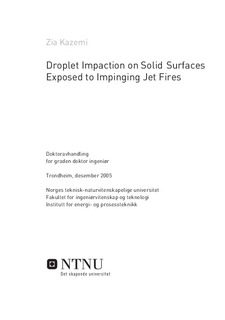| dc.description.abstract | The thermal response of hot surfaces exposed to impinging jet fire and subsequent impacting water droplets is investigated. The research was done mainly experimentally by utilizing three different concepts. This included experiments on a laboratory scale steel plate and large outdoor fire tests with a quadratic steel channel and steel plates. Besides the horizontal jet flame itself was characterized in a comprehensive study. As a comparative study, the last three types of the experiment were additionally modeled by the CFD-code Kameleon FireEx for validation of results.
Benchmark steel plate: The purpose of the experiments done on bench scale steel plate (L x W x T : 300 x 200 x 8 mm) was mainly to map data on wetting temperature, water droplet size, droplet impingement angle, and droplet velocity prior to large scale jet fire tests. The droplet release angle normal to hot surface gives best cooling effect, when the surface is oriented in upright position. The partial wetting begins at about 165 ºC. When the surface is positioned in horizontal plane, the droplet of about 5 mm in diameter wets the hot surface partially at around 240–250 ºC within an impaction distance of 20 cm. At about 150 ºC, the droplet is entirely attached to the surface with almost zero contact angle, and cools down the solid at a critical heat flux equivalent to 1750 kW/m2. The cooling effectiveness is about 8 % with a Weber number of 68.
Jet fire test with steel channel: Although in the event of horizontal channel (L x W x T : 1000 x 200 x8 mm) water droplets were not applied,however, the knowledge gained with jet fire tests gave valuable information about temperature progress in solids (steels and insulation) and their response to impinging jet fire during long duration experiments. The temperature of the insulated area of the channel keeps 200 ºC below that of the exposed surface, as long as the insulation material remained intact. Upon long test fire durations, the insulation either burns or degrades despite protection in a metal encasing. This possibly reveals that the passive fire protection does not necessary guaranty the solids subjected to fire would survive, when the exposure time is extended, although in this study the surface keeps its consistency.
Jet fire test with steel plates: Two types of plate (L xWx T : 300 x 300 x 10 mm) were employed, where one of them was insulated with 70 mm rockwool material on the rear side. Despite high elevated temperatures of the steel plates, one depressed the surface temperatures by water droplets from film boiling to nucleate boiling regime by a water mass flux of 4.4 kg/m2s per plate, when spray nozzles were located outside the flame region. As the gas pressure was raised from 5 bar to 10 bar, the average critical heat flux for non-insulated and insulated plate increased by about 40 % to around 2100 kW/m2 and 75 % to 2000 kW/m2, respectively. While the average minimum heat flux increased approximately by 35 % to 410 kW/m2 and 150 % to 380 kW/m2, respectively. The radiation level on the surrounding area within a 3 m radial distance increases by a factor of 1.5–2 upon increase of gas pressure. However, it drops by 25 % when deluge is applied, due to cooling of the flame. In case of spray nozzles located directly within the flame, the surface temperatures remained within nucleate boiling regime almost throughout the experiments. To ensure the temperatures are maintained at this regime, it requires a minimum mass flux of 1.1 kg/m2s per plate. However, to keep the dry patches completely away, the flow rate needs to be fortified to about 2.6-2.7 kg/m2s. The average droplet size (SMD) in the event of earlier is around 650 μm, while that of the later is about 450 μm.
Characterization of jet flame: The horizontal flame of concern was about 5.5 m long, in addition to a lift-off distance of 60 cm. The warmest region of the flame is about 70 % downstream the visible length of the flame, with an average temperature of about 1100ºC across the concerned cross section. The corresponding radiation at this section along the jet centerline is around 185 kW/m2. While the radiation level at 1.5 m radial distance outside the flame is about 50 kW/m2. The highest temperature of the flame across almost any cross section is somewhere between the flame core and the outer edge of the flame.
CFD verification: The CFD-code predicts well the exposed surface temperature of the steel channel, while that of the insulated area is predicted too high. The calculated surface temperature of the non-insulated steel plate is well comparable with that of the experiments, both before and after activation of deluge. But that of the insulated plate as well as the insulation | nb_NO |
